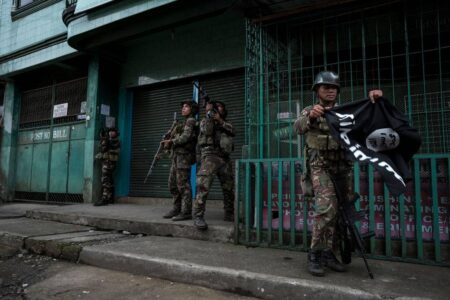
The Islamic State terrorist group is holding on in Philippines
Hundreds of millions of U.S. dollars and hundreds of hours spent working with and training Philippine government forces appear to be doing little to dislodge Islamic State fighters entrenched in the country’s south.
The assessment, part of a just-released Pentagon report, warns that at best, U.S.-supported efforts in the Philippines have fought IS and other terror groups to a stalemate, with Philippine forces unable to gain the upper hand.
“In general, efforts to reduce extremism in the Philippines do not appear to have made a substantial difference,” U.S. Defense Department Acting Inspector General Sean O’Donnell wrote in the report assessing the success of Operation Pacific Eagle–Philippines.
IS-East Asia and its partners “have remained about the same size and strength for the last few years,” O’Donnell added, noting there has been “little change” in their ability to finance and carry out operations.
The inability to deliver a more lasting defeat to IS in the Philippines comes despite considerable U.S. spending, including almost $70 million so far this year, down from more than $108 million last fiscal year, and just over $100 million the year before.
According to the inspector general report, a majority of that money has gone to intelligence, surveillance and reconnaissance, which includes the use of drones and other equipment to help Philippine forces hunt down IS cells.
But aside from some initial progress, when U.S. special forces aided Philippine efforts to recapture the city of Marawi, on the southern Philippine island of Mindanao, in 2017, efforts to eradicate IS have not met with sustained success.
Despite seeing 1,000 of its fighters killed or captured in the five-month-long battle for Marawi, and the death of its leader, Isnilon Hapilon, a month later, IS has persisted.
U.S. counterterrorism and military officials say IS has managed to keep its numbers in the low to mid hundreds.
The latest estimates, from the U.S. Defense Intelligence Agency indicate IS has anywhere from 300 to 500 fighters, divided into numerous factions, including the Abu Sayyaf Group, the Maute Group, Ansar Khalifa and others.
There are also indications that the terror group is spreading beyond its historical strongholds in the southern Philippines.
This past June, Philippine security forces said four IS fighters, part of a sleeper cell, were killed in a raid in the capital of Manila. And U.S. officials caution that IS continues to gain supporters across the country, even in areas where it is not currently fighting.
Source: VOA News





